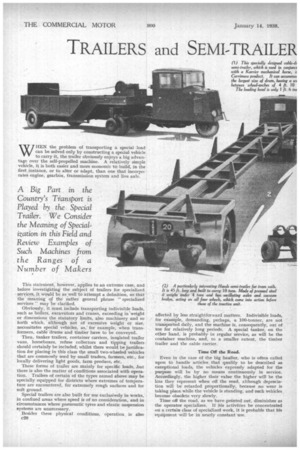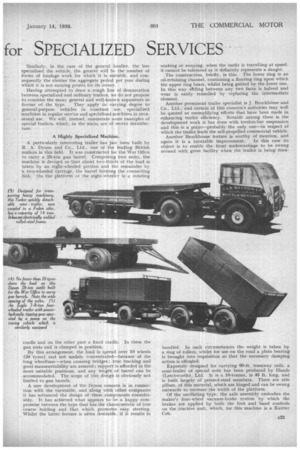TRAILERS and SEMI-T RAILER for SPECIALIZED SERVICES W HEN the problem
Page 18

Page 19

Page 20

Page 21

If you've noticed an error in this article please click here to report it so we can fix it.
of transporting a special load can be solved only by constructing a special vehicle to carry it, the trailer obviously enjoys a big advantage over the self-propelled mar.hine. A relatively simple vehicle, it is both easier and more economic to build, in the first instance, or to alter or adapt, than one that incorporates engine, gearbox, transmission system and live axle.
This statement, however, applies to an extreme case, and before investigating the subject of trailers for specialized services it would be as well to attempt a definition, so that the meaning of the rather general phrase "specialized services" may be clarified.
Obviously, it must include transporting indivisible loads, such as boilers, excavators and cranes, exceeding in weight or dimensions the statutory limits, also machinery and so forth which, although not of excessive weight or size, necessitates special vehicles, as,' for example, when transformers, cable drums and timber have to be conveyed.
Then, tanker trailers, container carriers, insnlated trailer vans, horseboxes, refuse collectors and tipping trailers should certainly be included, whilst there would be justification for placing in this class the small two-wheeled vehicles that are commonly used by small traders, farmers, etc., for locally delivering light goods, farm produce, etc.
These forms of trailer are mainly for specific loads, but there is also the matter of conditions associated with operation. Trailers of certain of the types named above may be specially equipped for districts where extremes of temperature are encountered, for extremely rough surfaces and for soft ground.
Special trailers are also built for use exclusively in works, in confined areas where speed is of no consideration, and in circumstances where pneumatic tyres and elastic suspension systems are unnecessary.
Besides these physical conditions, operation. is also c20
affected by less straightforward matters. Indivisible loads, for example, demanding, perhaps, a 100-tonner, are not transported daily, and the machine is, consequently, out of use for relatively long periods. A special tanker, on the other hand, is probably in regular service, as will be the container machine, and, to a smaller extent, the timber trailer and the cable carrier.
Time Off the Road.
Even in the case of the big haulier, who is often called upon to handle articles that qualify to be described as exceptional loads, the vehicles expressly adapted for the purpose will be by no means continuously in service. Accordingly, the higher their value the higher will be the loss they represent when oil the road, although depreciation will be retarded proportionally, because no wear is taking place while the vehicle is standing, and such vehicles become obsolete very slowly.
Time off the road, as we have-pointed out, diminishes as the operator specializes. If his activities he concentrated on a certain class of specialized work, it is probable that his equipment will be in nearly constant use. Similarly, in the case of the general haulier, the less specialized the vehicle, the greater will be the number of forms of haulage work for which it is suitable, and consequently the shorter the aggregate period per year during which it is not earning profits for its owner.
Having attempted to draw a rough line of demarcation between specialized and ordinary trailers, we do not propose to consider the many general and well-known arguments in favour of the type. They apply in varying degree to general-purpose vehicles in constant use, specialized machines in regular service and specialized machines in occasional use. We will, instead, enumerate some examples of special trailers, which, in the main,. are of recent manufacture.
A Highly Specialized Machine.
• A particularly interesting trailer has just been built by R. A. Dyson and Co., Ltd., one of the leading British makers in this.field, It was constructed for the War Office to carry a 28-ton gun barrel. Comprising two units, the machine is deviked so that about two-thirds of the load is taken by an eight-wheeled portion and the remainder by a two-wheeled carriage, the barrel forming the connecting link. On the platform of the eight-wheeler is a rotating
cradle and on the other part a fixed cradle. In these the gun rests and is clamped in position.
By this arrangement, the load is spread over 10 wheels (20 tyres) and not unduly concentrated—because of the long wheelbase—when crossing bridges ; true trackiv and good manceuvrability are assured ; support is afforded in the most suitable positions, and any length of barrel can be accommodated. The scope of this design is obviously not limited to gun barrels.
A new development of the Dyson concern is in connec= tion with the turntable, and along with other companies it has advanced the design of these .components considerably. It has achieved what appears to be a happy compromise between the type that has the characteristic of true course holding and that which promotes easy steering. Whilst the latter feature is often desirable, if it results in
snaking or swaying, when the outfit is travelling at speed. it cannot be tolerated as it definitely represents a danger.
The construction, briefly, is this. The lower ring is an oil-retaining channel, containing a floating ring upon which the upper ring bears, whilst being guided by the lower one. In this way sliding between any two faces is halved and wear is easily remedied by replacing the intermediate element.
Another prominent trailer specialist is J. BrockhOuse and Co., Ltd., and certain of this concern's activities may well be quoted as exemplifying efforts that have been made in enhancing trailer efficiency. Notable among these is the development work it has clone with torsion-bar suspension and this is a pain t--probably the only one—in respect of which the trailer leads the self-propelled commercial vehicle.
Another 'Brockhouse feature is worthy of mention, and again it is a turntable improvement. In this case its object is to enable the front undercarriage to be swung around with great facility when the trailer is being man handled. In such circumstances the weight is taken by a ring of rollers, whilst for use on the road a plain hearing is brought into requisition so that the necessary damping action is afforded.
Expressly designed for carrying 60-ft. tramway rails, a semi-trailer of special note has been produced by Hands (Letchworth), Ltd. It is a 10-tonner, is 45 ft. long, and is built largely of pressed-steel members. There are side pillars, of this material, which are hinged and can be swung outwards to increase the width of the platform.
Of the oscillating type, the axle assembly embodies the maker's four-wheel vacuum-brake system by which the brakes are applied by both the foot and hand controls on the ,tractive unit, which, for this machine is a Karrier Cob.
This system ensures that the trailing wheels are the first to be effected by brake application, which is an important point at all times, but especially when the length is so great.
Another specialized product of this cAncern is an extensible trailer of the pole type in which the central member comprises two box-section parts, one of which fits into the other.
A Carritnore product of similar type is a telescopic-pole trailer, a feature of which is that the wheelbase can be contracted from 19 ft. toll ft. 6 ins, without the pole projecting rearwards. A big demand, we understand, has been experienced for this type as a result of the recent shortage of steel. Certain demands of specialized services can be met by this concern's retractor coupling for semi-trailers, by which the gap between cab and trailer front can be minimized.
Among the machines made by Cranes (Dereham), Ltd., for specialized services may be instanced big-capacity vehicles for loads ranging from 15 tons to 100 tons. These are of the multi-wheeled type and include both trailers and semi-trailers.
For easy loading and anloading, certain types have detachable rear axles, permitting the platform end to be lowered to ground level. This, however, is not a unique feature. Recent improvements include a ball-bearing turn-table, which is standardized on four-wheelers.
One particular model, which certainly comes under our main heading, is a. 14-ton eightwheeler commissioned some time ago for supplying coal and ice to a fleet of trawlers. It is equipped with a Principality moving floor.
A pioneer of the articulated vehicle, Scammell Lorries, Ltd.; has a wealth of experience in semi-trailer building. For all classes of transport large numbers have been supplied, ranging from 3-ton and 6-ton models, for use with the mechanical horse,. to machines for indivisible loads weighing 100 tons. Tanker trailers are also a specialized Scarnmell product. The company has made a feature of interchangeability so that economic use can be made of one tractive unit in conjunction with several semi-trailers of different specialized types, and the employment of the same tank for the conveyance of different liquids--bitumen and milk for example —can easily be avoided.
Whilst Taskers of Andover (1032), Ltd., is associated in
the minds of many with timber drugs, this company actually manufactures a comprehensive range, which includes large machinery carriers. Representative of the type is a 14-ton quickly detachable low-loading semi-trailer, having a frame of roiled-steel-channel, and angle.-section members, in the construction of which electric welding is widely used. The example illustrated has a dropped platform 14 ft. long Whilst the platform is only 3.ft. 2 ins, above ground level.
Specific forms of employment May require the use of tipping trailers and a good example of such a machine is shown in an accompAnying. illustratioh of an Eagle trailer coupled to a large tipping lor-ry. .The former has a capacity of 7-S tons and the hydraulic rains on both units are fed by a pump on the lorry, a flexible pipe connecting it with the
i
Anothernteresting Eagle trailer is a six-wheeler
having a large all-steel van body with
lifting doors • along one side. This was built for the Metropolitan Water Board and is te be used for portable pumping plant.
Our picture of a Lolode. trailer is of special interest in that it is equipped as a dentist's clinic.
Light two-wheeled trailers and gravity—tipping trailers are specialized products of Henry Boys and Son.
Builders of specialized trailers to special order are Robert Stephenson and Hawthorns, Ltd„. Ransornes Sims and jefferies, Ltd., and the Projectile and Engineering Co., Ltd., the last-named embodying an ingenious overrunning brake.


































